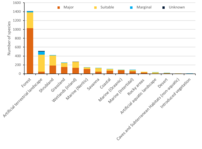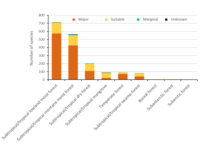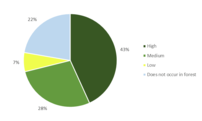
Threatened birds occur in all major habitat types but the majority (78%) are found in forests. Threatened species show a lower tolerance of human modified habitats (33.2% compared with 49.1% of all birds) and a large proportion occur in just one or two habitats (68.1%). Those that live in forest show a high dependency on the habitat and do not tolerate perturbation.

Birds are found across the world in all major habitat types. Most threatened birds show a clear preference for certain types of habitat, with 37.7% occurring in just one major type (e.g. forest, grassland) and 68.1% in one or two. Forests are one of the most important habitats for birds as shown in Fig. 1, supporting an impressive 78% of threatened bird species, with 27.6% partially or exclusively supported by shrubland, 15.7% by inland wetlands, and 16.3% by grasslands. Marine habitats support a higher than expected proportion of threatened birds (12.8%), while savannas are of lower importance than expected (8.6%). Only 33.2% of threatened species use an artificial habitat (compared with 49.1% of all birds), which as would be expected suggests that threatened species may be less tolerant of habitat modification. These species depend on adjacent natural or semi-natural habitats for breeding or feeding, but are able to use human-modified habitats to some extent.

Threatened birds are found in all forest types; tropical/subtropical moist lowland and montane moist forest are the most important habitats supporting 47.8% and 38.1% of species respectively, with tropical/subtropical dry forest supporting 13.8%., as depicted in Fig. 2. These forest types are also the most important for threatened mammal species, highlighting their extreme importance to wider conservation efforts (Hilton-Taylor 2000). Threatened forest birds are highly dependent on intact habitat for their survival; 20.3% of all bird species can be found in degraded forest but only 10.5% of threatened birds use such habitat, and for the majority of these it is only of marginal importance. The vast majority of threatened species for which forest represents a major or suitable habitat type (89.6%) show a strong dependency on the habitat; 71.1% of all threatened birds have high or medium dependence on forest, as outlined in Fig. 3.

Related Case Studies in other sections
References
Hilton-Taylor, C. (2000) 2000 IUCN Red List of threatened species. Gland, Switzerland and Cambridge, UK: IUCN.
Compiled: 2004 Last updated: 2020
Recommended Citation:
BirdLife International (2020)
Threatened birds occur in all habitats, but the majority are found in forest.
Downloaded from https://datazone.birdlife.org/sowb/casestudy/threatened-birds-occur-in-all-habitats-but-the-majority-are-found-in-forest on 23/12/2024